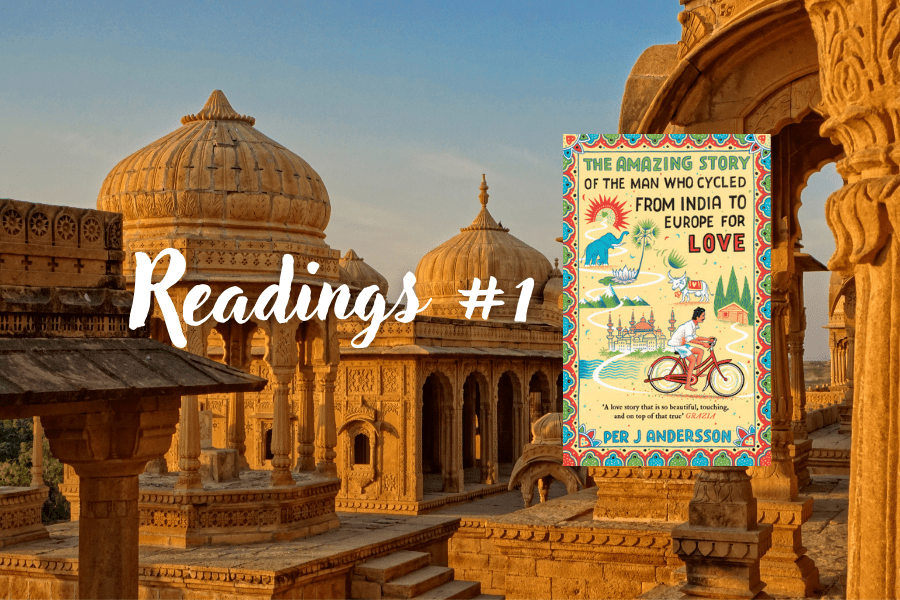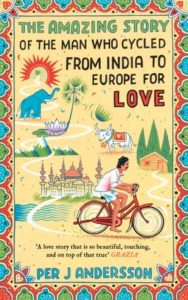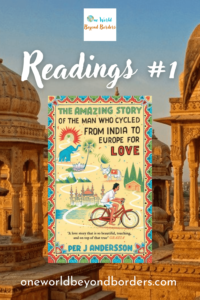
Readings #1 – The Amazing Story of the Man Who Cycled From India to Europe for Love

~ The Amazing Story of the Man Who Cycled From India to Europe for Love ~
Per J. Andersson
Summary
“You will marry a girl who will not come from this ethnic group, nor from this village, nor from this province, nor even from this country.” This prophecy, Pikej, a young Indian born in a family of the Dalit caste, has been repeating it to himself all his life. When he meets Lotta, a Swedish woman on a trip, at the foot of a fountain in New Delhi, the young street artist is sure: it’s her. The girl of the prophecy.
He can’t afford the trip to find her on the edge of the North Sea. So, without hesitation, he embarks on an incredible 7000-kilometer journey by bicycle to reach her…
My opinion
This book is a favorite. It is at the same time an immersion into the Indian society, a travel story and an international love story.
Thanks to this book, I could once again immerse myself in the atmosphere of India that I had the chance to visit a few years earlier.
This Bollywood-like story is all about hope and resilience.
I thought at first I was reading a fictional novel, but nay. Per J. Andersson, a Swedish writer and journalist, tells a true story. A simple Internet search allowed me to see the pictures of Pikej and Lotta. You can find some here or there.
Contrary to what the title suggests, this is not only a bicycle trip but also a description of the traditional Indian society and the caste system through the eyes of a Dalit. The whole first part of the book is dedicated to the childhood and youth of Pikej, born in a family of Dalits. In the caste system the Dalits, or Harijans, are considered to be out of the castes and are relegated to functions or jobs considered impure. They are victims of numerous discriminations, which is perfectly illustrated by Pikej’s story. In order to escape from his condition and to follow his passion, he goes to the Indian capital to study fine arts.
The story of his youth is a true metaphor of resilience: the young man is at the very bottom of the social ladder, struggles against the most bitter poverty before becoming a street artist and meeting some of the most important personalities of the time, including Indira Gandhi.
This book also partially immerses us in the hippie movement of the 1970s. Through his work as a street cartoonist, Pikej began to rub shoulders with Westerners who traveled the Hippie Trail to India and Kathmandu. Later, his desire to join Lotta, a Swedish woman he has fallen in love with, will push him to travel the Hippie Trail in the opposite direction.
Per J. Andersson’s story also deals with the mixed or intercultural couple. The author highlights the meeting between the two protagonists as well as the obstacles that stand in their way. But love knows no boundaries, and the story of Pikej and Lotta proves it.
Some quotations
“Before Pikej went to school, he didn’t know anything about castes. No one had explained to him that men were divided into four categories and thousands of sub-categories. He had never heard of the Rig-Veda, the collection of sacred hymns dating back thousands of years, in which the origin of the castes is described. He did not know that the brahmins, or priests, came from Purusha’s mouth, the kshatriyas, or warriors, from his arms, the vaishyas, or traders, craftsmen and peasants, from his thighs, and the sudras, or workers and servants, from his feet.”
“All men have the same vital energy, regardless of their origin and skin color. When you think like that, it’s impossible to be racist, Lotta thought.”
“The bike trip is endless, and the dangers many. Some people would consider hir project doomed to failure. Only his refusal of all logic allows him to keep pedaling. So far, he hasn’t met anyone who considers his bike trip to Sweden unfeasible. The road is full of people like him. Tireless travelers. Conscientious objectors who reject their culture. In addition to the usual hippies, he also meets economic refugees; Asians on their way to the rich Europe. With his fellow travelers, he shares a common feeling: that anything is possible.”
“There are many dark clouds in front of the sun, but one day the wind blows them away.”
Did you like this blog post? Pin it!







